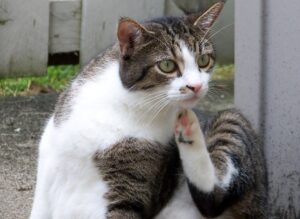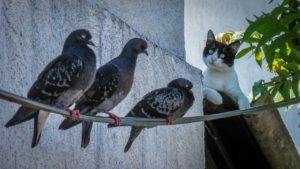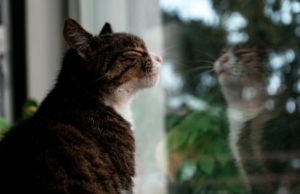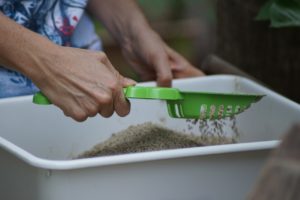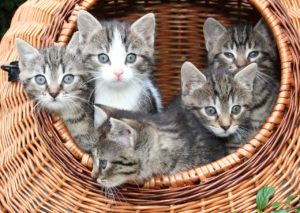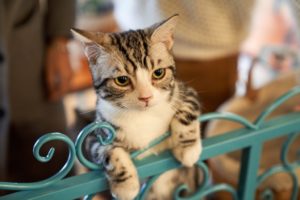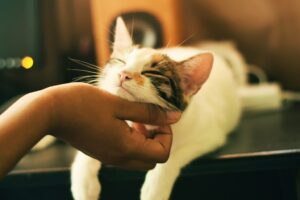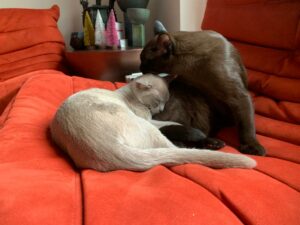The secret to preventing weight gain for your cat lies in feeding a suitable diet in the correct amounts, and also ensuring your cat gets enough exercise. However, this is not always as easy as it sounds and we are going to explore some practical ways you can put these principles into action.
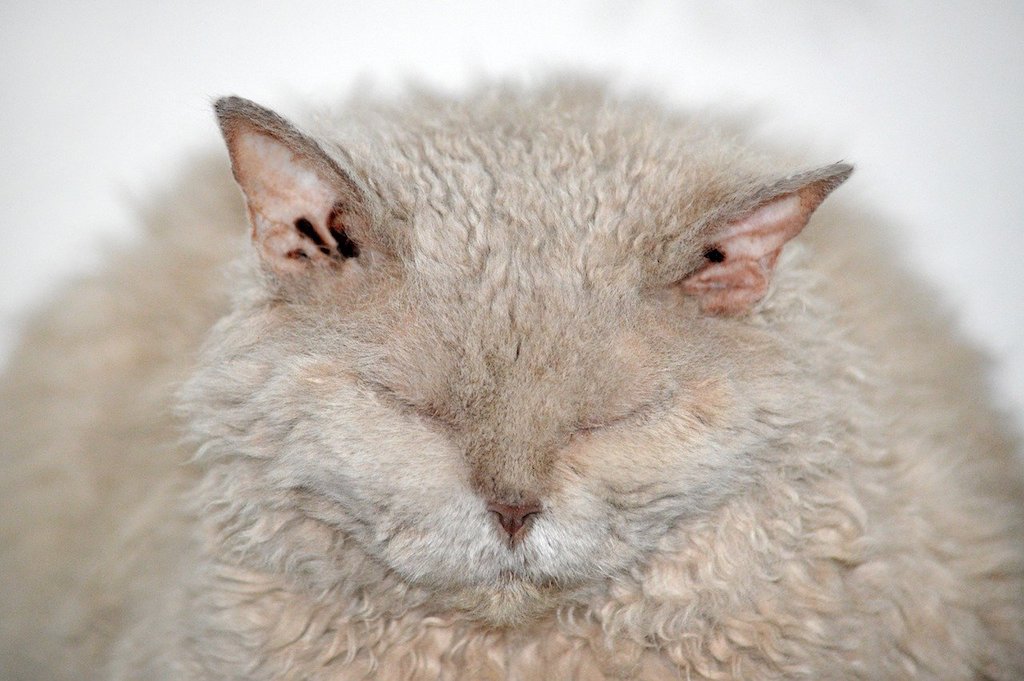
Why Is Feline Obesity a Problem?
Cats are considered to be overweight when they are 10-19 percent heavier than their optimum weight. When they are 20 percent or more than their normal weight they are classed as obese. For example, if your cat’s healthy weight is 4kg but they gradually creep up to 5kg, they would then be considered obese.
Obesity in cats increases the risk of many diseases, including diabetes mellitus, cystitis, osteoarthritis and skin disorders. An obese cat will also have reduced stamina and exercise tolerance; this creates a cycle of reduced exercise and ever-increasing bodyweight. Life expectancy is also reduced in obese cats, so it is vital that we keep our feline friends in a fit and healthy condition in order for them to live a long and happy life!
Monitoring Your Cat’s Weight
Monitoring your cat’s weight is actually easier than it sounds, and is the best way to quickly identify if they are putting on a few extra pounds. Most of us will have our cats weighed when we visit the vets for routine healthcare so this is an easy place to start. Have a chat with your veterinary surgeon or veterinary nurse to find out if your cat is at a healthy weight, and keep a note of your cat’s weight to compare at your next visit.
How to weigh your cat
If you have a set of bathroom scales it is also possible to monitor your cat’s weight at home. Firstly weigh yourself and then again when you are holding your cat; the difference between these two weights is the weight of your cat. You could also try this with a cardboard box if your cat is one of those who finds boxes irresistible! Weighing your cat at home regularly will help to identify if they are gaining or losing weight. Remember that this measurement of weight may not be as accurate as the scales at the vets, so don’t panic if your result is different to the vets clinic.
How to Select the Correct Food for Your Cat
Shopping for cat food can be overwhelming at times, with so many different types of food available! This can also be complicated by the fact that cats are renowned to be fussy eaters. Once you find the right diet then many cats will happily eat the same food every day.
Meeting your cat’s nutritional needs
The easiest way to monitor your cat’s food intake is to just feed one type of food. Look for a product which is ‘complete’; meaning that it will meet all of your cat’s nutritional needs. Cheaper foods may be poorer quality so your cat might still appear to be hungry after eating the recommended daily amount. Mid or high range products contain better quality ingredients and should satisfy your cat’s appetite when fed in the correct quantities.
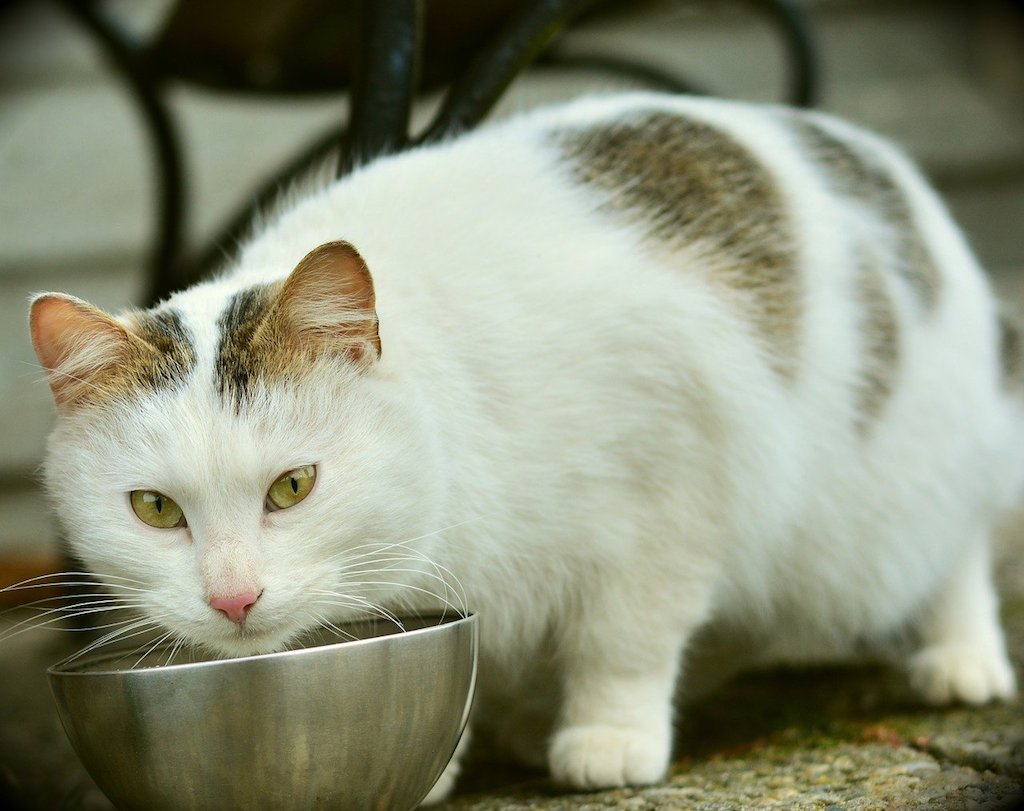
Choosing between wet or dry food can be tricky. If your cat shows a preference for one type then you may find it easier to stick to this. A combination of the two can be fed but you will need to calculate carefully how much your pet needs of each type to avoid calorie overload.
Cat age and food
The life stage of your pet should also be taken into consideration when selecting a food. Most pet food manufacturers now make diets aimed at particular life stages. A young adult cat will have high activity levels and may need a higher calorie diet. Neutered cats have lower energy requirements due to a reduced metabolic rate, and therefore a lower calorie diet is recommended. Elderly cats also have different nutritional needs – they use less calories but cannot digest food as efficiently.
How to Feed the Right Amount of Food
Luckily, pet food manufacturers make this really easy for us! On the packaging you will find recommendations of the amount to feed according to the weight of your cat. If your pet is slightly over their ideal weight then feed the amount recommended for the weight you are aiming for. To feed a mix of wet and dry food, the simplest way to calculate the amount required is to feed half the recommended amount of each food.
Finding the right portion size
Now that you’ve worked out how much food your cat should be having each day, how do we break this down into meals? Cats can be notoriously greedy feeders and most of us will have experienced the howls of a cat claiming to be starving! The aim is to satisfy your cat’s appetite whilst also encouraging them to use energy while doing so.
Finding the right feeding frequency
One easy tip is to weigh your cat’s daily dry food allowance into a measuring cup each morning. You can then give them small amounts through the day to satisfy their hunger. When feeding a mix of wet and dry food, it might be preferable to split the wet food into two or more meals, and allow them to graze on the dry food in-between meals.
Whatever type of food is being given, it is preferable to split this into as many meals as practically possible. Multiple meals will increase activity levels throughout the day, reducing boredom and using more energy.
If you have more than one cat it can be tricky to ensure that each gets their own food allowance. Cats are notoriously territorial and establishing a feeding station for each cat in separate zones of the house can be very effective.
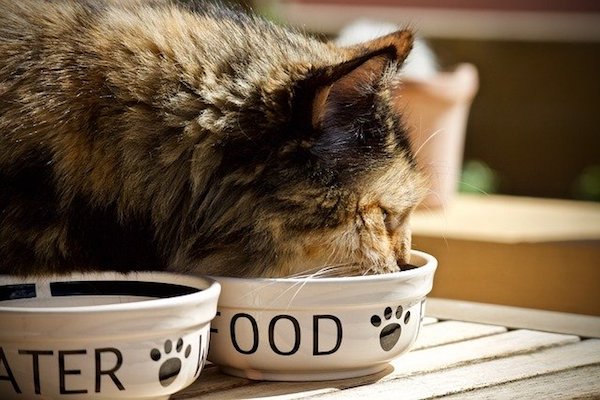
How to Ensure That Your Cat Is Getting Enough Exercise
Benefits of exercise
Most of us don’t think about exercising our cats, but it can be a fun and rewarding way to spend time with your pet. Cats become less active as they gain weight. The more exercise they get the more playful and active they will become. Monitor how much time your cat spends being active compared to sleeping. Don’t be afraid to encourage them to become a bit more active.
Cats are most active in the morning and the evening. Schedule in some time before or after work or school to play with your cat each day. Playtime is also a huge benefit to the mental health of your cat, preventing boredom and providing stimulation. You may find that after a few weeks of daily play sessions your cat is generally more playful.
Ideas for cat exercises
Spending just 10 to 15 minutes per day encouraging your cat to play is a great place to start. All cats are different so take some time figuring out what stimulates them to play. This could be chasing, stalking, hunting, pouncing – most cat playtime revolves around practicing hunting skills! Scheduling playtime just before a meal can also give your cat the satisfaction of having ‘caught’ their dinner.
If it is safe to do so, encourage your cat to spend time outside each day. Exploring the local environment will help to expend energy and also provide mental stimulation. If your cat cannot go outside then look at ways to make the environment indoors more stimulating. Use climbing towers and cat trees to encourage them upwards. Large open floor spaces are excellent for encouraging chasing behaviour.
Using Toys, Puzzles and Feeding Stations
Toys
Cat toys come in all shapes and sizes, they can be as simple as a ball to chase or even a leaf from the garden to squash. Most cats have a favourite type of toy, such as a fluffy mouse or feathered bird. Interactive toys are also available which may have flashing lights or sounds. Whichever toys you get for your cat, be prepared to replace them regularly. Hunting behaviour can quickly turn that fluffy mouse into a chewed up rag!
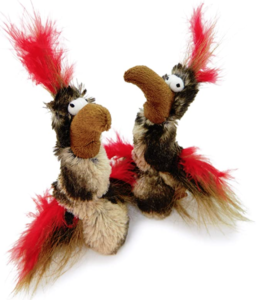
Cats may be less interested in toys which are left out all of the time. In this situation consider using a toy box to store a different toys, changing them each day or at each play session. Some toys are only suitable for use under supervision, such as string or toys containing batteries.
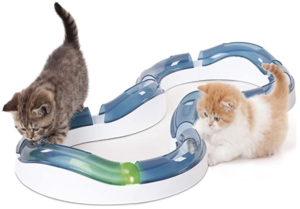
View on Amazon
Puzzles
The ideal puzzle will take time for your cat to figure out, providing mental stimulation whilst also using energy. Puzzles can be home made or bought from a shop. A great example is a ball with a hole in one side into which some cat biscuits are placed. The cat can only release the biscuits by playing with the ball. Remember to only use food from your cat’s daily allowance for these types of activities.
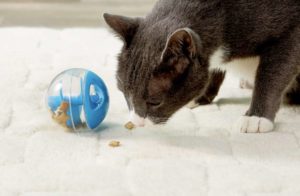
View on Amazon
Feeding stations
Timed feeding stations are available which split the daily ration into smaller meals throughout the day. These can be very useful when you need to leave your cat alone for longer periods, such as for work. Microchip activated cat feeders are a good option to make sure that each cat eats only its own rations in a multi-cat household.
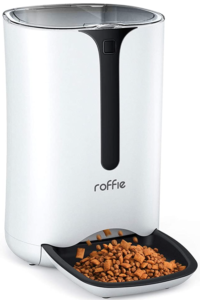
View on Amazon
Feeding stations can also incorporate puzzles to help slow down your cat whilst eating. This will help your cat to feel that its hunger has been satisfied, as the overall feeding time has been prolonged. Something as simple as a silicone moulded mat in the bottom of a food bowl will significantly slow down eating times. More complex labyrinth-style feeding stations are also available which are excellent for satisfying your cat’s hunting instincts.
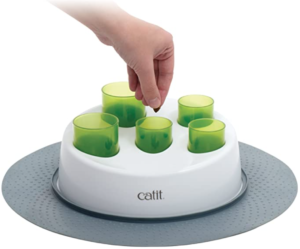
Keeping your cat fit and healthy – the responsibility of a good cat parent
As you can see, it can be very easy to make small changes to your cat’s lifestyle in order to keep them at a healthy weight. Keeping to a diet plan doesn’t have to mean that your cat pesters you for food, and it can be very rewarding. Taking control of your furry friend’s diet is one of the most responsible things a pet owner can do, and there really is no better reason to play with your cat every day than to keep him healthy!

